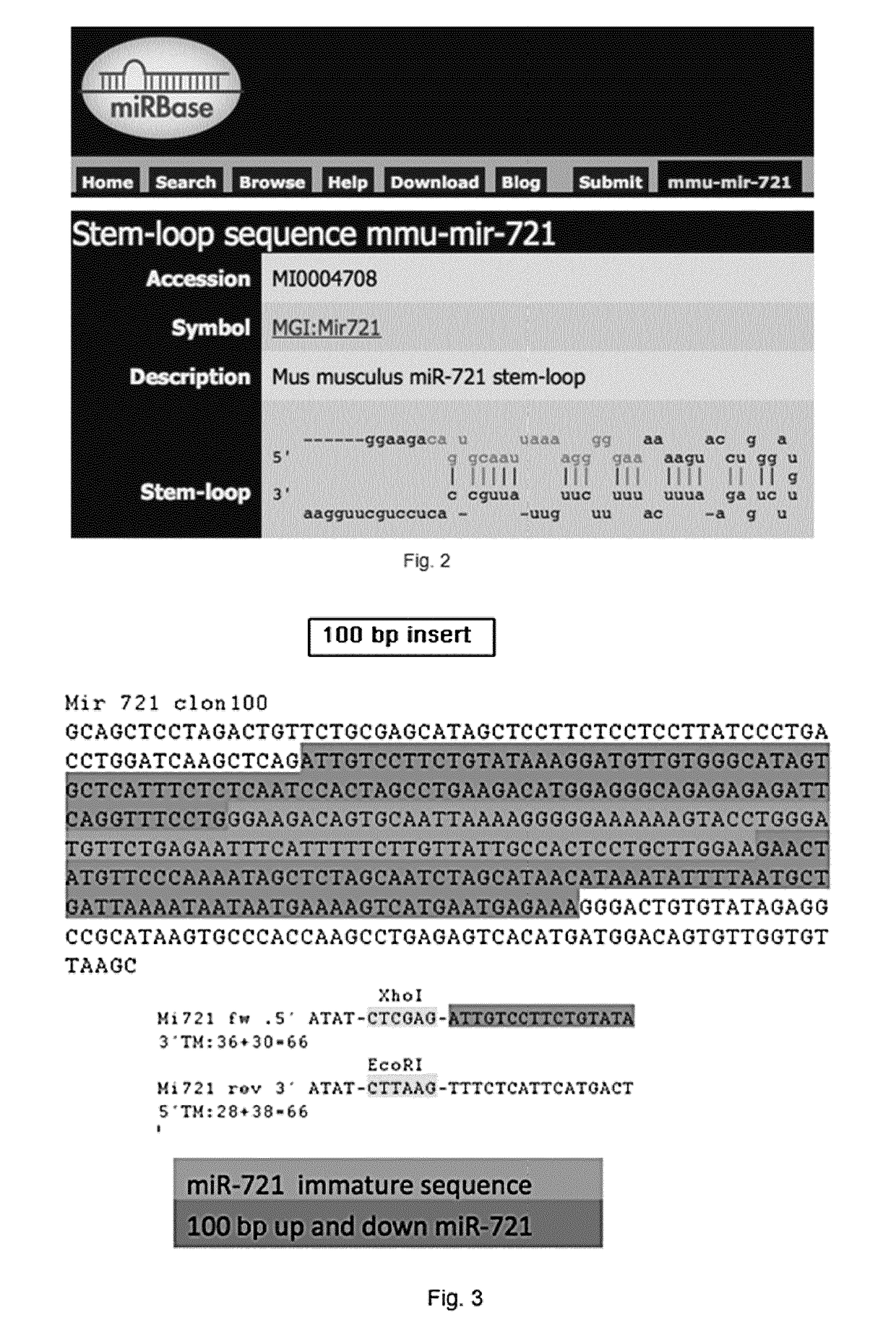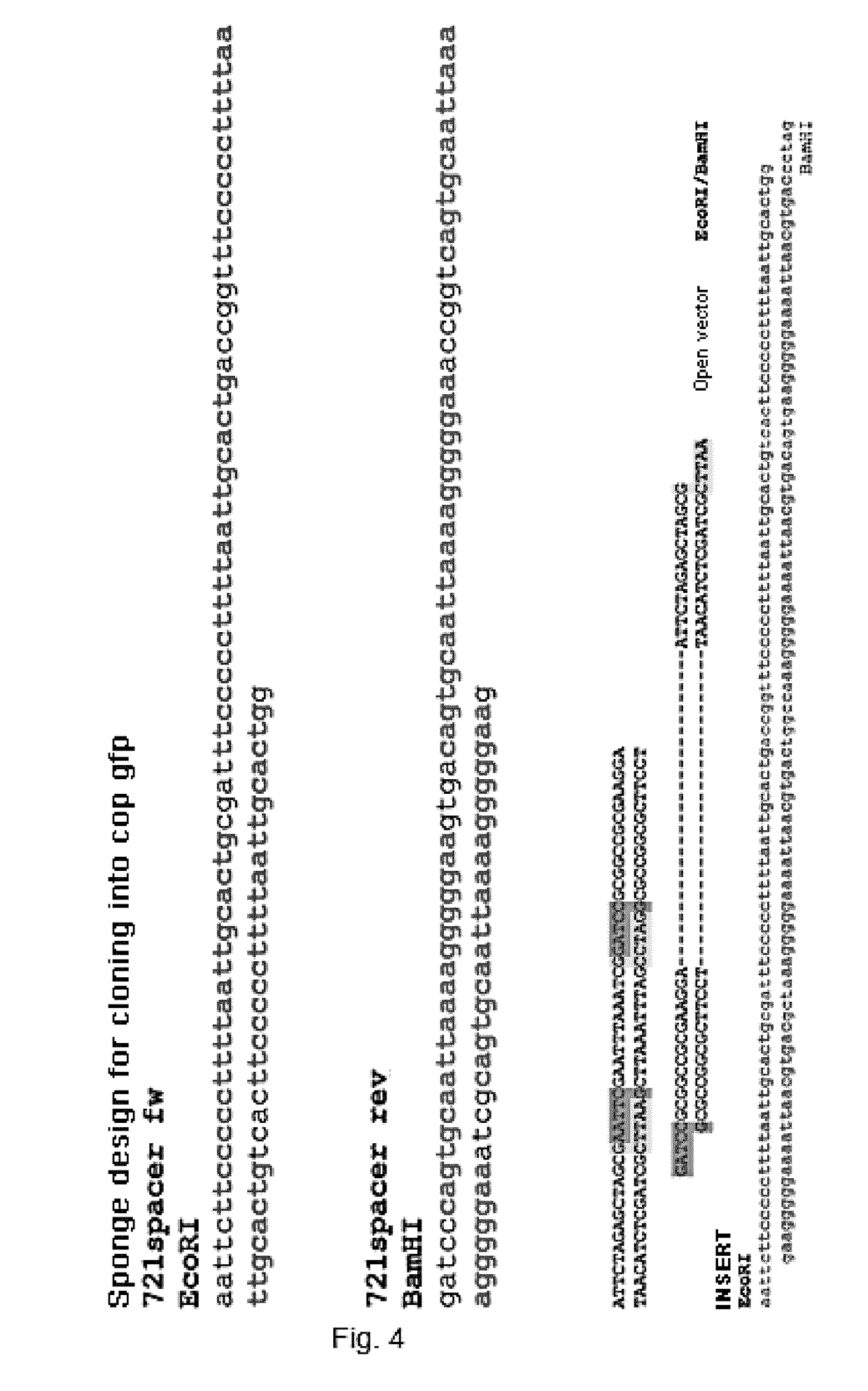Method for diagnosing cardiomyopathies
a cardiomyopathy and cardiomyopathy technology, applied in the field of cardiomyopathy diagnosis, can solve the problems of difficult echo findings, substantial discrepancy in the predictive value of the proportion of treg lymphocytes circulating in blood in patients, and little research on t/sub>h/sub>,
- Summary
- Abstract
- Description
- Claims
- Application Information
AI Technical Summary
Benefits of technology
Problems solved by technology
Method used
Image
Examples
example 1
iRNA-721 and Characterizing its Target Genes
[0105]miRNA-721 was first described in a paper on mouse embryon brain tissue, in which the expression thereof during central nervous system embryogenesis was studied (Wheeler et al., FEBS Letters 2006). In this paper, miRNA was identified as miRY and was subsequently entered in the miR Base as mir-721. This miRNA is located in chromosome 5 within the non-coding region of CUX1 gene. miR-721 belongs to the family of miRNAs miR-130 / 301 / 721 (FIG. 1).
[0106]To study this microRNA in depth and its role in regulating inflammation and therefore in cardiovascular diseases, miRNA was cloned into expression vectors to conduct loss and gain of function assays, as well as for the functional validation of the possible target genes of this miRNA. Since the assays must essentially be conducted in primary cells, retroviral and lentiviral expression vectors have been tested, because they are the most efficient tools for gene expression in mammalian cells giv...
example 2
[0119]2.1. In Vivo Experiments for Validating the Role of miR-721 in the Th17 Cell Effector Function
[0120]Since the study of miR-721 function in the experimental autoimmune myocarditis (EAM) model requires very extensive experiments and working highly inaccessible tissue, the myocardium, a mouse lower limb muscle mouse ischemia model that is widely used in research to study the peripheral arterial disease (PAD) has been developed in the laboratory. To that end, the animals are subjected to a surgery explained next: a 5 mm incision is made in the inguinal area of the left leg allowing exposure of the femoral nerve, vein and artery. The connective tissue is carefully separated, and the vein, artery and nerve are dissected by means of separating the arterial adventitia layer close to the area distal to the femoral artery bifurcation. Once the three components are separated, the femoral artery is ligated by carefully passing thereunder a suture thread and making two surgical knots close...
example 3
MIR721 and MIR155 Expression in the Animal Model of Experimental Autoimmune Myocarditis
[0134]According to the results obtained, CD69-deficient naive T CD4+, T regulator and TH17 lymphocytes have changed the expression pattern of various microRNAs. The CD69 molecule limits the severity of cardiac dysfunction in the model of experimental autoimmune myocarditis (EAM) by means of controlling TH17 responses. To that end, this model is used to investigate the role of the previously mentioned miRNAs in this disease. The murine model of EAM is induced by means of immunization with a peptide derived from the α-myosin heavy chain (MyHCα) specific for heart tissue emulsified with CFA (Complete Freund's Adjuvant), which causes effector TH17 cell activation and differentiation. 21 days after immunization, the mice are in the acute phase of the disease, presenting inflammation in the myocardium and anti-cardiac myosin antibodies in serum. The chronic phase appears after 56 days, characterized by ...
PUM
| Property | Measurement | Unit |
|---|---|---|
| diameter | aaaaa | aaaaa |
| temperature | aaaaa | aaaaa |
| MRI | aaaaa | aaaaa |
Abstract
Description
Claims
Application Information
 Login to View More
Login to View More - R&D
- Intellectual Property
- Life Sciences
- Materials
- Tech Scout
- Unparalleled Data Quality
- Higher Quality Content
- 60% Fewer Hallucinations
Browse by: Latest US Patents, China's latest patents, Technical Efficacy Thesaurus, Application Domain, Technology Topic, Popular Technical Reports.
© 2025 PatSnap. All rights reserved.Legal|Privacy policy|Modern Slavery Act Transparency Statement|Sitemap|About US| Contact US: help@patsnap.com



